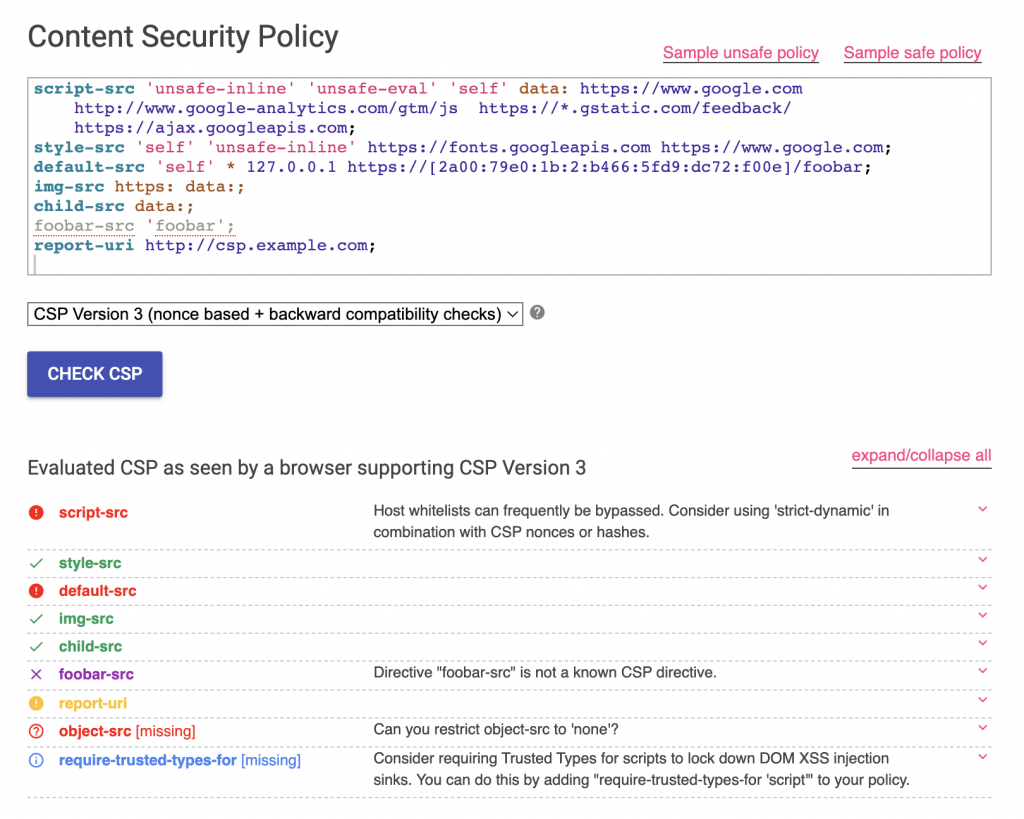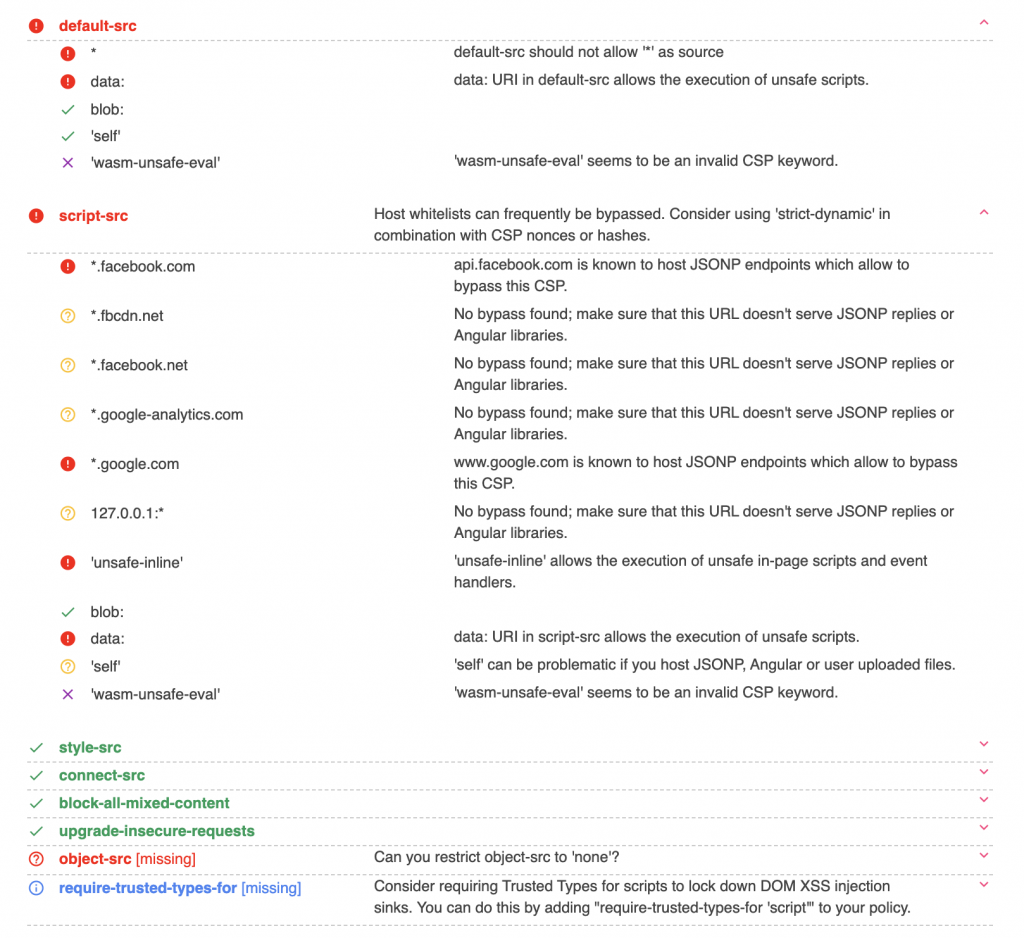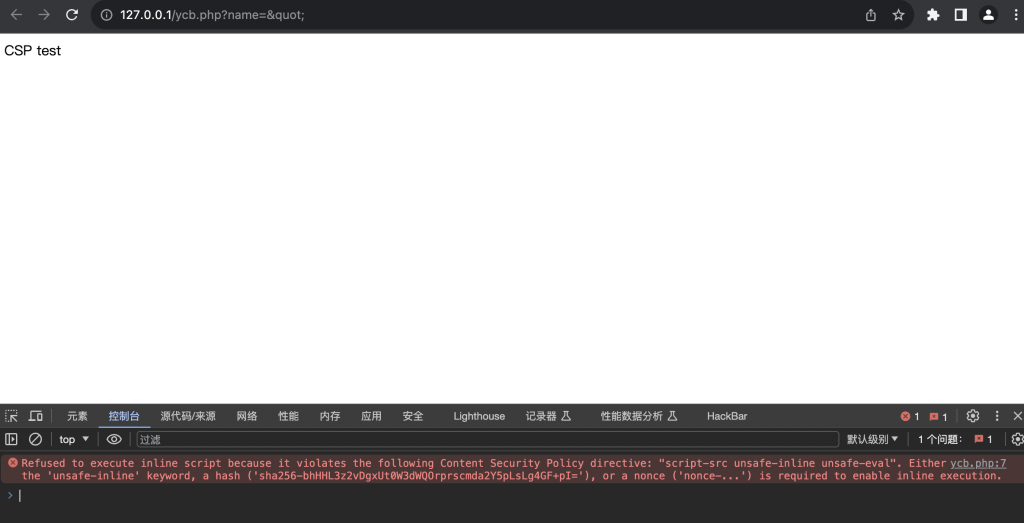XSS 的第一道防線就是把使用者的輸入處理乾淨,確保內容是沒有問題的。但說起來容易,做起來難,尤其是對一些 legacy 的專案來講,程式碼又亂又雜又多,要修哪裡都不知道。
再者,寫程式時也可能會失誤,通常會發生資安問題有三種原因:
第一種就像是前面一再提到的 <a href> 的例子,你可能不知道這裡面能放 javascript: 來執行程式碼。
第二種像是你知道 XSS 漏洞,你知道輸出應該要先做編碼,但你忘了。
第三種則是你擺明知道這邊沒編碼會有洞,而且應該要編碼,但因為專案的時程壓力或是老闆的指示所以不管它。
像是第一種的例子,你根本不知道那邊要做處理,不知道這樣會有漏洞,那該怎麼防禦?這就是為什麼我們需要第二道防線的理由之一。
CSP,全名為 Content Security Policy,可以翻作「內容安全政策」,意思就是你可以幫自己的網頁訂立一些規範,跟瀏覽器說我的網頁只允許符合這個規則的內容,不符合的都幫我擋掉。
想要幫網頁加上 CSP 有兩種方式,一種是經由 HTTP response header Content-Security-Policy,另外一種是經由 <meta> 標籤,因為後者比較容易示範,我們先以後者為主(但實際上比較常用的是前者,因為有些規則只能透過前者來設定)。
(其實還有神秘的第三種,<iframe> 的 csp 屬性,但那個又是別的議題,我們不會講到)
直接來看個範例:
<!DOCTYPE html>
<html>
<head>
<meta http-equiv="Content-Security-Policy" content="script-src 'none'">
</head>
<body>
<script>alert(1)</script>
CSP test
</body>
</html>
在上面的網頁中,宣告了 CSP 為 script-src 'none',意思就是:「這網頁不允許任何 script 的執行」,所以 body 中的 script 最後不會執行,如果打開 DevTools 的話會看到錯誤訊息:
Refused to execute inline script because it violates the following Content Security Policy directive: "script-src 'none'". Either the 'unsafe-inline' keyword, a hash ('sha256-bhHHL3z2vDgxUt0W3dWQOrprscmda2Y5pLsLg4GF+pI='), or a nonce ('nonce-...') is required to enable inline execution.
這就是為什麼我把 CSP 稱作是第二道防線,當你的第一道防線(處理使用者輸入)失效時,還可以靠著 CSP 阻止 script 或其他資源的載入,一樣可以及時防止 XSS 漏洞。
CSP 可以定義的東西就是:指示(directive)加上規則,像剛剛就是指示 script-src 配上規則 'none',最終的結果就是阻止任何 JavaScript 的執行。
先提醒一點,這邊的指示 script-src 不能輕易解讀為「script 標籤的 src」,這裡的 script 代表的就是一般的「腳本」的意思,不是專指 script 標籤,也不是專指 src 屬性。
舉例來說,假設頁面上有 <a href="javascript:alert(1)">click</a>,這一段 HTML 沒有 script 標籤也沒有 src,點下去之後依然會被 CSP 阻擋並出現錯誤訊息,因為 script-src 'none' 的意思就是:「阻止任何 JavaScript 的執行」,無論是用 script 標籤、event handler 還是 javascript: 偽協議,結果都是一樣的。
那指示有哪些呢?
最重要的一個叫做 default-src,就是預設的規則,例如說沒有設置 script-src,那就會用 default-src 的內容,但要注意的是有幾種指示不會 fallback 到 default-src,如 base-uri 或是 form-action 等等,完整列表可以看這邊:The default-src Directive
其他的指示大概有以下幾種(我會省略一些不常用到的):
script-src:管理 JavaScriptstyle-src:管理 CSSfont-src:管理字體img-src:管理圖片connect-src:管理連線(fetch、XMLHttpRequest 以及 WebSocket 等等)media-src:管理 video 跟 audio 等等frame-src:管理 frame 以及 iframe 等等base-uri:管理 <base> 的使用form-action:管理表單的 actionframe-ancestors:管理頁面可以被誰嵌入report-uri:待會再講navigate-to:管理頁面可以跳轉到的地方是不是很多種?而且這個列表是會變化的,例如說最後的 navigate-to 就是比較新的東西,目前的瀏覽器都還沒有支援。
除了這些其實還有滿多個,但比較不常用的我就沒有特別寫了,有興趣的可以到 MDN: Content-Security-Policy 或是 Content Security Policy Reference 去看。
那這每一個可以搭配的規則又有哪些呢?根據指示的不同,也會有不同的規則可以使用。
基本上常見的規則有以下幾種:
*,允許除了 data: 跟 blob: 還有 filesystem: 以外所有的 URL'none',什麼都不允許'self',只允許 same-origin 的資源https:,允許所有 HTTPS 的資源example.com,允許特定 domain(HTTP 跟 HTTPS 都可以)https://example.com,允許特定 origin(只允許 HTTPS)例如說 script-src * 基本上有設跟沒設差不多,而 script-src 'none' 直接不讓你執行任何的 JavaScript。
另外,有些規則是可以疊加的,以實務上來說很常會看見這樣的規則:
script-src 'self' cdn.example.com www.google-analytics.com *.facebook.net
有時候 script 會放在 same-origin,所以需要 self,有些會放在 CDN,所以需要 cdn.example.com,而因為有裝 Google Analytics 跟 Facebook SDK,所以要 www.google-analytics.com *.facebook.net,才能載入他們的 JavaScript。
完整的 CSP 就是這些東西的組合,指示之間用 ; 隔開,像是這樣:
default-src 'none'; script-src 'self' cdn.example.com www.google-analytics.com *.facebook.net; img-src *;
透過 CSP,我們可以告訴瀏覽器說哪些資源允許載入,哪些不行,讓攻擊者就算找到了注入點,也不一定能執行 JavaScript,就不是一個 XSS 漏洞了,能夠降低影響力(但當然還是要修啦,只是風險比較小)。
除了可以規範載入資源的 URL 以外,還有其他的規則可以使用。
例如說設置了 CSP 以後,預設是禁止 inline script 還有 eval 的,這裡被封鎖的 inline script 包括:
<script> 標籤裡面直接放程式碼(應該要用 <script src> 從外部引入)onclick 這種寫在 HTML 裡面的 event handlerjavascript: 偽協議要使用 inline script 的話,需要加上 'unsafe-inline' 這個規則。
而若是要像 eval 那樣,把字串當成程式碼來執行,則是要加上 'unsafe-eval' 這個規則。有些人可能知道 setTimeout 其實也可以把字串拿來當程式碼執行,像這樣:
setTimeout('alert(1)')
還有 setInterval 跟 Function 等等,也都可以做到一樣的事情,這些都需要加上 'unsafe-eval' 才能使用。
除了這些之外,還有 'nonce-xxx',意思是在後端產生一個隨機字串,例如說 a2b5zsa19c 好了,那有帶上 nonce=a2b5zsa19c 的 script 標籤就可以載入:
<!-- 允許 -->
<script nonce=a2b5zsa19c>
alert(1)
</script>
<!-- 不允許 -->
<script>
alert(1)
</script>
還有類似的 'sha256-abc...',意思是允許特定 hash 的 inline script,例如說 alert(1) 拿去做 sha256 之後會得到一個 binary 的值,base64 過後會是 bhHHL3z2vDgxUt0W3dWQOrprscmda2Y5pLsLg4GF+pI=,因此底下範例中只有內容剛好是 alert(1) 的 script 會載入,其他都不會:
<!DOCTYPE html>
<html>
<head>
<meta http-equiv="Content-Security-Policy" content="script-src 'sha256-bhHHL3z2vDgxUt0W3dWQOrprscmda2Y5pLsLg4GF+pI='">
</head>
<body>
<!-- 允許 -->
<script>alert(1)</script>
<!-- 不允許 -->
<script>alert(2)</script>
<!-- 多一個空格也不允許,因為 hash 值不同 -->
<script>alert(1) </script>
</body>
</html>
最後還有一個也可能會用到的是 'strict-dynamic',意思就是:「符合規則的 script 可以載入其他 script 而不受 CSP 限制」,像這樣:
<!DOCTYPE html>
<html>
<head>
<meta http-equiv="Content-Security-Policy" content="script-src 'nonce-rjg103rj1298e' 'strict-dynamic'">
</head>
<body>
<script nonce=rjg103rj1298e>
const element = document.createElement('script')
element.src = 'https://example.com'
document.body.appendChild(element)
</script>
</body>
</html>
在我們設置的 CSP 中,只有 nonce-rjg103rj1298e 是允許的 script,並沒有允許其他來源,但是從 <script nonce=rjg103rj1298e> 裡面新增的 script 不受限制,可以動態新增其他來源的 script,這就是 'strict-dynamic' 的功用。
在設置 CSP 的時候,通常都以 default-src 'self' 起手,預設 same-origin 的資源都是可以載入的。
接著先來處理最重要的 script,通常最優先的事項是最好不要有 'unsafe-inline' 跟 'unsafe-eval',因為有了這兩個以後,有設跟沒設的差別就不大了。
我們加上 CSP 的初衷是什麼?想要當成 XSS 的第二道防線,但如果加上了 unsafe-inline,就親手瓦解了這道防線,只要隨便插入一個 <svg onload=alert(1)> 就可以執行程式碼。
不過現實生活沒有這麼美好,通常都會有一些以前的 inline script,讓我們不得不加上 unsafe-inline,這邊教大家一個常見的處理方式。例如說 Google Analytics 好了,會要你在網頁上加入底下的程式碼:
<script async src="https://www.googletagmanager.com/gtag/js?id=UA-XXXXXXXX-X"></script>
<script>
window.dataLayer = window.dataLayer || [];
function gtag(){dataLayer.push(arguments);}
gtag('js', new Date());
gtag('config', 'UA-XXXXXXXX-X');
</script>
這就是我們最想避免的 inline script,那該怎麼做呢?在 Google 所提供的官方文件:使用代碼管理工具搭配內容安全政策中就有提及,我們剛剛其實也有講到,兩種解法:
sha256-xxx 的規則這兩種解法都可以執行特定的 inline script,而不是依靠權限全開的 'unsafe-inline'。除此之外,官方文件也有提醒如果要使用「自訂 JavaScript 變數」的功能,必須要打開 'unsafe-eval' 才有用。
如果你不確定你設置的 CSP 是否安全,可以到這一個 Google 提供的網站:CSP Evaluator,它會偵測你的 CSP 是否有錯誤,以及是不是安全,如下圖所示:

雖然前面有提到沒設好的 CSP 跟沒設差不多,但當然還是有設定會比較好,畢竟跨出了第一步嘛,有很多公司以前可能連有 CSP 這種東西都不知道,有加了就值得鼓勵,之後再慢慢改進就好。
文章前半段有提到一個「report-uri」的指示,這是個非常貼心的功能。CSP 如果沒設好的話,很有可能會阻擋正常的資源,導致網站無法正常使用或是部分功能壞掉,這就得不償失了。
因此,有另一個叫做 Content-Security-Policy-Report-Only 的 header,意思就是你可以設定 CSP,但是不會真的阻擋,只會在載入違反規則的資源時送一個報告到指定的 URL。
透過這個功能,我們就可以先觀察有哪些違反 CSP 的狀況發生,從這些 log 中看看有沒有沒設定好的 CSP,確認都沒問題之後才改用 Content-Security-Policy。
你有看過什麼是一大串 CSP 嗎?
來看一下 GitHub 首頁的 CSP,讓大家體會什麼是一大串:
default-src
'none';
base-uri
'self';
child-src
github.com/assets-cdn/worker/
gist.github.com/assets-cdn/worker/;
connect-src
'self'
uploads.github.com
objects-origin.githubusercontent.com
www.githubstatus.com
collector.github.com
raw.githubusercontent.com
api.github.com
github-cloud.s3.amazonaws.com
github-production-repository-file-5c1aeb.s3.amazonaws.com
github-production-upload-manifest-file-7fdce7.s3.amazonaws.com
github-production-user-asset-6210df.s3.amazonaws.com
cdn.optimizely.com
logx.optimizely.com/v1/events
*.actions.githubusercontent.com
productionresultssa0.blob.core.windows.net/
productionresultssa1.blob.core.windows.net/
productionresultssa2.blob.core.windows.net/
productionresultssa3.blob.core.windows.net/
productionresultssa4.blob.core.windows.net/
wss://*.actions.githubusercontent.com
github-production-repository-image-32fea6.s3.amazonaws.com
github-production-release-asset-2e65be.s3.amazonaws.com
insights.github.com
wss://alive.github.com github.githubassets.com;
font-src
github.githubassets.com;
form-action
'self'
github.com
gist.github.com
objects-origin.githubusercontent.com;
frame-ancestors
'none';
frame-src
viewscreen.githubusercontent.com
notebooks.githubusercontent.com;
img-src
'self'
data:
github.githubassets.com
media.githubusercontent.com
camo.githubusercontent.com
identicons.github.com
avatars.githubusercontent.com
github-cloud.s3.amazonaws.com
objects.githubusercontent.com
objects-origin.githubusercontent.com
secured-user-images.githubusercontent.com/
user-images.githubusercontent.com/
private-user-images.githubusercontent.com
opengraph.githubassets.com
github-production-user-asset-6210df.s3.amazonaws.com
customer-stories-feed.github.com
spotlights-feed.github.com
*.githubusercontent.com;
manifest-src
'self';
media-src
github.com
user-images.githubusercontent.com/
secured-user-images.githubusercontent.com/
private-user-images.githubusercontent.com
github.githubassets.com;
script-src
github.githubassets.com;
style-src
'unsafe-inline'
github.githubassets.com;
upgrade-insecure-requests;
worker-src
github.com/assets-cdn/worker/
gist.github.com/assets-cdn/worker/
基本上各種能設定的都設定了,而我們最關注的 script,只設定了 github.githubassets.com;,是滿安全的設定方式。
而且 GitHub 的賞金計畫中有一個特殊的類別叫做 GitHub CSP,只要你可以繞過 CSP 並且執行程式碼,就算你沒有找到可以注入 HTML 的地方也算數。
接著看一下 Facebook:
default-src
*
data:
blob:
'self'
'wasm-unsafe-eval'
script-src
*.facebook.com
*.fbcdn.net
*.facebook.net
*.google-analytics.com
*.google.com
127.0.0.1:*
'unsafe-inline'
blob:
data:
'self'
'wasm-unsafe-eval'
style-src
data:
blob:
'unsafe-inline'
*
connect-src
secure.facebook.com
dashi.facebook.com
dashi-pc.facebook.com
graph-video.facebook.com
streaming-graph.facebook.com
z-m-graph.facebook.com
z-p3-graph.facebook.com
z-p4-graph.facebook.com
rupload.facebook.com
upload.facebook.com
vupload-edge.facebook.com
vupload2.facebook.com
z-p3-upload.facebook.com
z-upload.facebook.com
graph.facebook.com
'self'
*.fbcdn.net
wss://*.fbcdn.net
attachment.fbsbx.com
blob:
data:
*.cdninstagram.com
*.up.facebook.com
wss://edge-chat-latest.facebook.com
wss://edge-chat.facebook.com
edge-chat.facebook.com
edge-chat-latest.facebook.com
wss://gateway.facebook.com
*.facebook.com/rsrc.php/
https://api.mapbox.com
https://*.tiles.mapbox.com
block-all-mixed-content
upgrade-insecure-requests;
雖然也是一大串,但可以注意到 script 有開了 'unsafe-inline',是比較不安全的做法,如果把這串 CSP 貼到前面講的 CSP Evaluator,也是跳一堆紅字出來:

我自己其實滿推薦大家設定 CSP 的,只要設定了以後,就多了一道防線,這樣在問題發生時至少還有機會挽救,透過 CSP 阻擋攻擊者的 XSS payload,讓損害降到最低。
而且門檻不高,可以先從 report only 開始,邊觀察邊調整網站的 CSP 規則,確定不會影響到一般使用者以後再正式上線。
最後一樣來個小測驗,在之後的文章會解答。
小明看完這篇之後回頭看了一下自己的專案,發現 JavaScript 的檔案都來自於 https://unpkg.com 上的套件,因此加上了如下的 CSP,請問 script-src 的部分有什麼問題?
Content-Security-Policy: script-src https://unpkg.com;

請問
我用了下面的代码
<!DOCTYPE html>
<html>
<head>
<meta http-equiv="Content-Security-Policy" content="script-src *">
</head>
<body>
<script>alert(1)</script>
CSP test
</body>
</html>
但是不管是firefox还是chrome,都把我拦截了,要求我设置nonce的代码的sha256
這應該是因為 * 針對的是 URL,如同說明中寫的:「*,允許除了 data: 跟 blob: 還有 filesystem: 以外所有的 URL」
如果要 inline 的話還是需要加上 'unsafe-inline' 這個關鍵字,可能是文中「例如說 script-src * 基本上有設跟沒設差不多」這句有點誤導了
用上unsafe-inline可以了,感谢